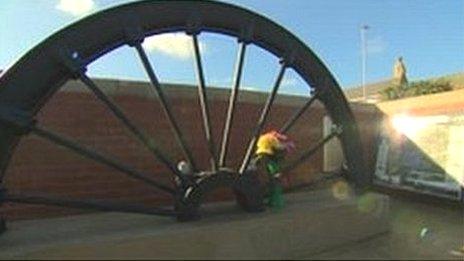Miners' strike 30 years on: Worth the price?
- Published
- comments

A new memorial is one of the few remaining traces of a century of mining in the former pit village of Dodworth
It was a bit like that famous scene in the film Zulu.
A small band of nervous British troops silently watching the horizon for the first glimpse of a warrior army they had never seen but with a ferocious reputation.
But this was a pit gate in North Staffordshire in March 1984 and marching towards the thin blue line of uniformed police officers were a couple of hundred miners who had just got off their buses from Barnsley.
It was dawn on day one of the miners' strike against planned pit closures. I was there with a television news crew to film the first glimpse of the flying pickets from Yorkshire.
Local Staffordshire miners had already told me they were not going to cross any picket lines so the comparison with a well-rehearsed film script was not too far off the mark.
Opening shots
That relatively good humoured first morning gave no hint that we were looking at the opening shots of what became the most fiercely-fought industrial strike in modern industrial history.
For the following 12 months, based in the Midlands as a reporter for ITV, I regularly met Yorkshire miners bussed in through the night to picket pits in areas that were not as solidly behind the strike as back home.

Former Dodworth miners Jack Carr and Steve Wyatt interviewed by Len Tingle for BBC Look North
Thirty years on I've been to some of those South Yorkshire communities where the pickets came from to ask whether the struggle was worth it?
"No question of it," I was told by former collier Steve Wyatt as we stood by a newly-installed monument to nearly a century of mining at Dodworth, near Barnsley.
Steve's absolute conviction is despite the fact that the memorial's small replica pit wheel is now the only trace left of nearly a century of mining in the village.
The strike failed to secure the future of the huge Dodworth Colliery which once stood a five-minute walk away from where Steve and I were standing along with Jack Carr, in 1984 NUM Branch Secretary at the pit but now a local councillor.
"We had no choice. The strike was an attack on our communities," said Jack. "OK, so we lost in terms of keeping the collieries open, but we couldn't just let it happen without a fight."
Road to nowhere
In fact, Yorkshire now has just two collieries left from the 56 operating before the strike. A workforce of over 80,000 is now down to under 800. Three decades later the fight is still going on to replace those lost jobs.
Dodworth has been luckier than most. The bulldozed pit top has now been redeveloped and 2,000 people work in the new industries that have moved on to what is now an industrial estate.
"It's a great achievement but the jobs are nowhere near as well paid or secure as what we had in the pit," I was told by Jack.
Other former coal communities have not fared so well.
Twenty miles away, on the outskirts of Doncaster, the lane that hundreds of miners used to tramp down for their shifts at Thorne colliery is now the road to nowhere.
It has been barricaded with reclaimed structural steel and bits of old conveyor belt to stop motorcyclists and vandals but the flattened pit top remains as untouched and derelict as the day the bulldozers moved off.
"We've been forgotten," I was told by George Derx, the mayor of the local town council of Thorne Moorends. "Shops, businesses and jobs moved out when the local pits shut down and they haven't come back."
For communities like this the miners' strike is no mere footnote in history. Here they are still living with the consequences of what miners see as their failure to stop the government from its wholesale dismantling of the industry.